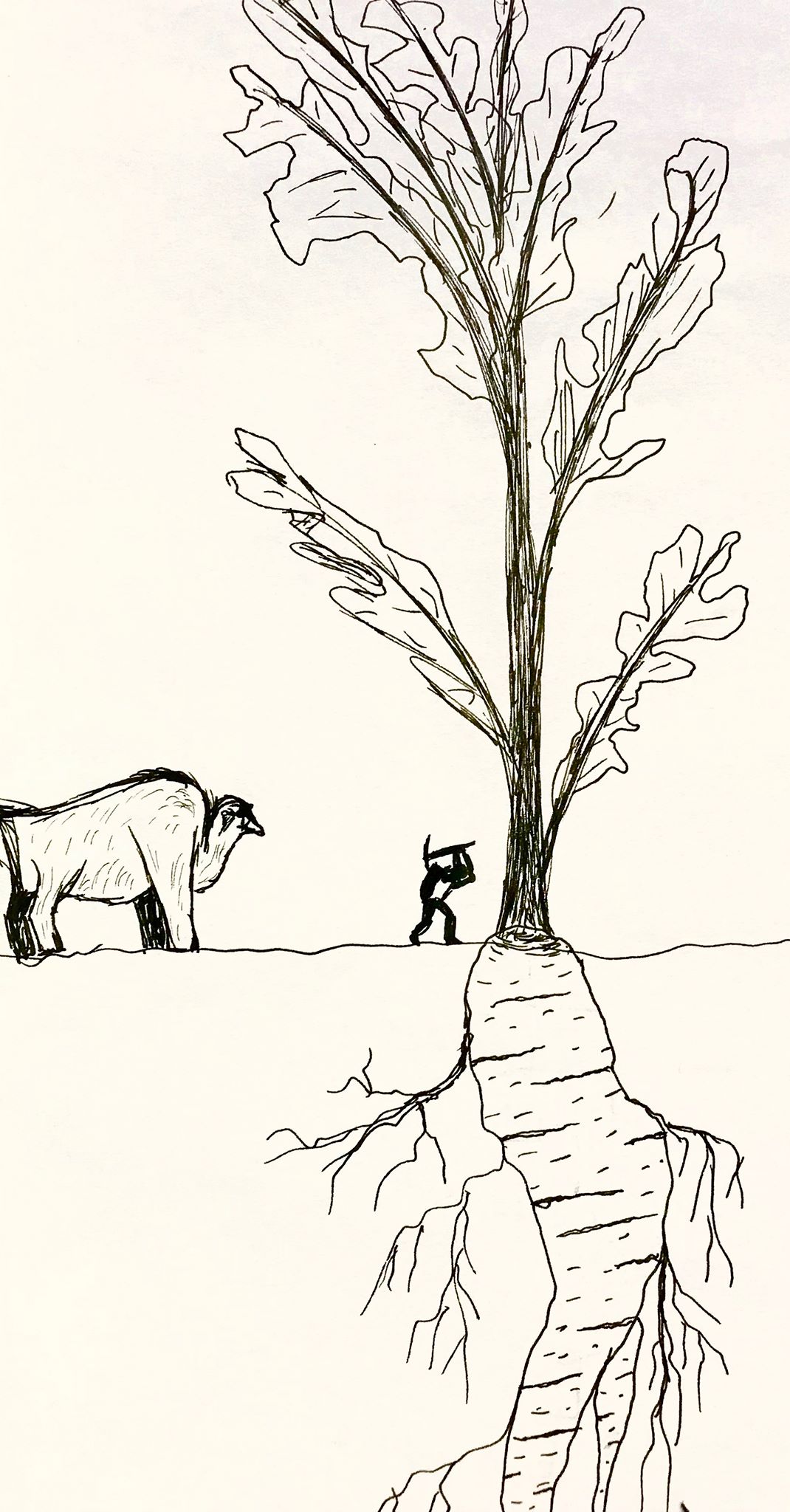Fanais
The green gold of the south
It was back in 5.I, when Elder Georre brought a batch of large seeds back from his expedition south of Lemiit isthmus. He had traded with a small community of Magissens, buying these sour and sticky seeds in exchange for a few lumps of dried meat.
Through their unintelligible language, Elder Georre understood that it could be eaten, but did not see how it was supposed to be prepared.
He offered them to the lord of the young colony, who ended up disgusted when his cooks tried using them boiled in a soup. So Elder Georre brought the seeds back to the rebaari temple, and he finally tried planting them in the temple's backyard.
Sixteen years later, were six trees of more than a cord in height, with large flexible leaves and a smooth and fuzzy crust. But the biggest surprise was barely visible, protruding from the soil by only a few dactyls, was the top of a very large, cylindrical root. The tuber was almost four crosses in diameter. After one tree was broken by a storm, Elder Georre decided to try digging the root out to look at it more closely. Little did he know then that if would take a good week with five workers to dig all the way down the base of the root, and two large heavers to haul it out of the trench.
From the root's wounds where the workers' shovels had been pushed too much, a transparent liquid was oozing. Elder Georre took the chance to taste it, and it was sweet, tasty and rich. Soon, all the elders and passerbys in the temple wanted to give a try to this vegetal nectar.
The root was cut in sections, and its pale, greenish pulp ended up very tasty and fresh, although a bit gelatinous.
In the years and decades following that day, from the seeds produced by the five surviving trees, Elder Georre and all the elders who succeded him have perfected the care, spread the seeds and selected the strains, for Fanais to become one of the main food sources in the south, and the most cultivated tree in Boomal, from the islands of Siiem in the East to the borders ot the Sea of Ivory in the West.
Anatomical Description
The shoot is taller than a five-story building, and can exceed 120 crosses. A wide stem supports ten to thirty huge leaves, that can easily reach a dozen crosses in length. Tle leaves are delicately lobed and so thin that they are easily shredded by strong winds. Underground, the central root is swollen with sugary reserves, that will be used when the mature tree goes through its first and final bloom. the root's flesh is a bit gelatinous, very rich in sugar and vitamins. It can range from a very light green, almost white, to deep crimson red.
When blooming, the tree produces thousands of large and delicate flowers, grouped in clusters that hang from the base of every leaf. It produces large amounts of pollen that spread in the wind, then the fruits start to grow to the size of a child's palm.
Growth
Soon after sprouting, the sapling will start growing a dense corolla at ground level, fith short and thick leaves.
During the first eight to fifteen years if its growth, the tree will store large amounts of energy in its tuber while growing in height and producing successive leaves.
For best yields and in deference to the elder who took care for his mysterious trees for sixteen years, farmers usually harvest the tuber during veesii of the sixteenth year of growth.
Uses and Explotation
It can take ten days for one person to dig out the whole tuber, not by excavating it as a whole but most often by digging its insides out in small blocks and vegetal pulp.
The blocks are then used tresh to be eaten raw or steam-cooked, or can be dried in flat portions. It makes for a perfect food to bring along a land or sea venture, and is even used as food for heavers.
Digging also produces amorphous pulp, which is too gooey and sticky to be sold, so it is often used by farmer families to bake large, dry loafs by adding flour. These can be kept for the whole year, be used to feed livestock, or be sold for a very affordable price.
Geographic Distribution
Fanais can be grown in warm climates, where water can be supplied sufficiently. They don't do well in dry, drained soils, or in colder climates where they will suffer from frost. Thus, they are cultivated mainly around Amaal, in the east, southeast and southwest of the Golden Sea, as well as in the tropical archipelago in the east. the northernmost region where they ae grown is in the centre of Lemiit isthmus.
Scientific Name
Tuberus verdis
Origin/Ancestry
East from the Golden Sea
Average Height
100 cr for the shoot, 70 cr for the root
Average Weight
the root can provide with on average 30 barrels of flesh.





Comments